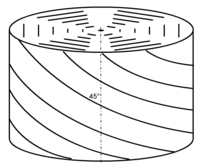Blue phase mode LCD
[1] This operational mode for LCDs also does not require anisotropic alignment layers (e.g., rubbed polyimide) and thus theoretically simplifies the LCD manufacturing process.
In Reinitzer's reports from 1888 on the melting behaviour of cholesteryl benzoate, there is a note that the substance briefly turned blue as it changed from clear to cloudy upon cooling.
This subtle effect remained unexplored for more than 80 years until experimental results were published during the late 1960s and early 1970s that indicated that the blue color was due to at least two new and very different liquid crystalline phases.
[4] In 2005, researchers from the Centre of Molecular Materials for Photonics and Electronics at the University of Cambridge reported their discovery of a class of blue-phase liquid crystals that remain stable over a range of temperatures as wide as 16-60 °C.
[6] The new blue phases are made from molecules in which two stiff, rod-like segments are linked by a flexible chain, and are believed to be stabilized due to flexoelectricity.
Samsung unveiled a 15 inch prototype model of its Blue Phase LCD panel at the SID (Society for Information Display) 2008 international Symposium, Seminar and Exhibition, which was held in Los Angeles from May 18 to 23, 2008.
Additionally it has been claimed that Blue Phase panels would reduce the sensitivity of the liquid crystal layer to mechanical pressure which could impair the lateral uniformity of display (e.g. luminance, chromaticity).
For a detailed discussion of the blue phase LCs in in-plane switching (IPS) structures and related modeling method based on the Kerr effect in a macroscopic scale see references.





